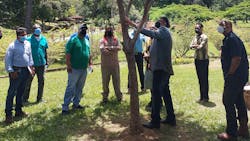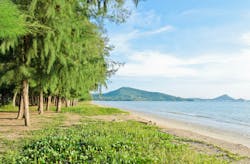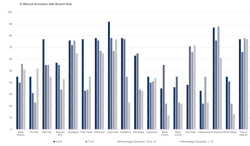In the United States, the strategies are evolving as utilities gather data and employ newer technologies, ranging from advanced plant health-care detection tools to mapping and the use of satellite data. Companies are using this data to better inform and guide work planning and deliver arboricultural, ecological and economic return on investment. Globally, the urban tree canopy cover and tree resources are now of special concern due to the interconnectedness of climate effects.
In this light, the nation is now paying attention to and becoming appreciative of the lessons learned from frontline regions of the world. These areas tend to have longer growing seasons and sometimes more heightened and apparent climate effects. In addition, they have experienced, or are experiencing, even more challenges and changes in vegetation and a higher frequency of erratic weather systems.
Plants respond to change and evolve with sites as conditions change, resulting in more rapidly occurring plant dynamics and/or plant migration. As climate effects are not always apparent, research narratives in these frontline areas, such as island nations and the global south, can help Americans understand the relatable challenges that may come their way.
Exploring International Regions
For several years, researchers have looked at changing plant populations and plant dynamics in utility and urban areas through several international frontline regions. Sea level rise is a global phenomenon. Apart from water levels rising, the secondary effects of salinity intrusion and loss of biodiversity to more salt-tolerant plant communities are very telling. A drought’s primary effects of stunting, defoliation and branch dieback may cause loss of structural integrity. Secondary effects may include the rise of tree pests and pathogens. Conversely, in many cases, heavy rainfall and flooding lead to whole tree failure, broken branches and pathogens associated with earlier tree mortality.
Considering Tree Resources as a System
In agriculture, it’s easier to consider a systems approach. As in many cases, it may be a monoculture of plants or a limited mixed crop situation. These agro-ecosystems can be monitored and managed. Although cropping in climate resiliency efforts has considerable challenges, its core objective is to raise plants from seeds to seedlings to the whole plant, then yield. This process may be relatively short-term in nature, but still wholly-related to the arboricultural process.
In terms of limitations, apart from site, care of seedlings, and plant establishment, seed stock has often been touted as a limiting factor. To build tree resources globally, this must be addressed. In several tropical frontline areas, seed stock is derived from naturally occurring and other local plantings and re-introduced to the landscapes via area nurseries as seedlings grown in bags. These smaller seedlings take off with relative ease and can adapt to sites with sometimes higher survivorship compared to planting larger trees. Notably, trees in the tropics are often planted in areas where similar species are already doing well in adjacent locations (Insert Figures 1 a, b, and c).
Tree Structural Assets as a Factor of Stability
Tree-inherent properties, including growth rates, branch aspect ratios and percentage branches with included bark are all indicators of tree potential for strength or failure. By assembling a database of recently planted trees, attaching inherent properties and comparing them to more established trees, it’s possible to begin to understand biodiversity and its relationship to tree species and structural tree integrity assets as trees grow in a particular geography. Trees planted in ecosystems or in stands generally fare better in high wind-loading environments (Insert Figure 2).
To capture this data globally, Tree Biomechanics International (TBI) was formed and is a growing series of sites that come together for tropical tree structural research. TBI sites are found in Belize, the Caribbean, Micronesia, Mexico, Columbia and other countries including the global south (Insert Figure 3).
Are there lessons that can be applied here in the United States? As the country experiences warmer winters and longer, hotter summers, for many species, the impact is already occurring. The fall season in temperate areas allows for trees to regroup energy and heal wounds such as accidental branch breaks, stem wounds and pruning cuts.
With reduced fall seasonal times, will this be a factor for tree survival and future tree structural integrity? Wound eclosion (healing in pruning cuts) is being measured across several sites in the United States, and several species of trees are beginning to demonstrate higher eclosion rates compared to others. This may be a more cohesive parameter to figure out what species are becoming more successful at surviving climate change (Insert Figures 4a and b.
Zoning in on Tree Biomechanics
Conventional edge-hardening efforts often rely on visual tools and management cycles based on system analytics over time. However, dynamic climate readiness and programs dictate a need for adaptability, additional metrics and overall system-level solutions and can borrow from national and international case studies on tree biomechanics.
The inclusion of tree biomechanics considerations in ROW forestry programs means that system foresters can better engage climate readiness at a level that provides greater emphasis on tree structure and stability. The lessons learned from frontline regions can inform processes in the United States. For example, the biomechanical scoring systems in tropical areas based on survivorship, coupled with plant inherent characteristics, can be adapted for temperate trees.
Dr. Anand Persad ([email protected]) is the director of the Research, Science and Innovation (RSI) team at ACRT Services. He is the research committee chair for the Utility Arborist Association, chair of the International Society of Arboriculture Science and Research Committee and actively works with city, state and federal organizations. He earned his Ph.D. in invertebrate ecology/entomology from the University of the West Indies.
About the Author
Anand B. Persad
Anand Persad, Ph.D., BCE is the director of research, science and innovation for ACRT Services.






